Fordlandia: Henry Ford's Company Town Deep in the Amazon Rainforest
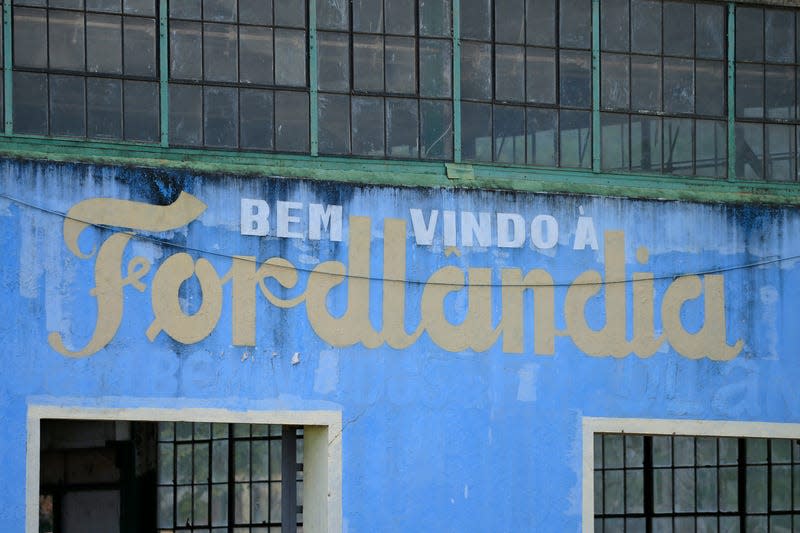
Elon Musk purchased thousands of acres of pasture land outside of Austin with the vision of building Snailbrook, a town (or someday, city) adjacent to Boring and SpaceX facilities already operational or under construction in the area. Ever since Musk announced plans for his updated version of the company town, I’ve been thinking about Fordlandia—a slice of suburban Detroit dropped by Henry Ford, then one of the richest men in the world, deep in the heart of the Amazon rainforest.
Nearly a full century before Snailbrook, Ford struck out to create his own unusual vision for the perfect community–a rubber plantation deep in the dark and mysterious forests of Brazil that would perfectly marry agriculturalism and industrialism to provide a self-actualized workforce. Far from corrupting vices like jazz, speakeasies and cow’s milk, the perfect worker couldn’t help but inevitably spring from the tamed Ford-branded soil.
Read more
Green Hell
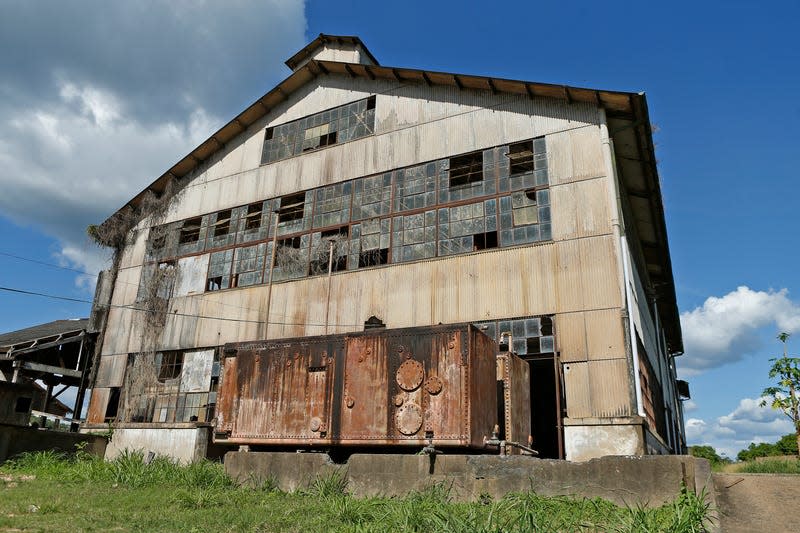
Because what worked for Ford in Dearborn, Michigan, would obviously work in the Amazon…right? The Amazon, which Teddy Roosevelt described as a green hell when he nearly died on an expedition just 14 years before Ford set boots down in the jungle in 1928. The Amazon, which receives roughly four times the amount of rain that fairly dreary Dearborn gets in a year. Here’s how director Werner Hertzog described it in 1980—35 years after Ford closed up shop for good:
I would see fornication and asphyxiation and choking and fighting for survival and... growing and... just rotting away. Of course, there’s a lot of misery. But it is the same misery that is all around us. The trees here are in misery, and the birds are in misery. I don’t think they - they sing. They just screech in pain. It’s an unfinished country. It’s still prehistorical. The only thing that is lacking is - is the dinosaurs here. It’s like a curse weighing on an entire landscape. And whoever... goes too deep into this has his share of this curse.
Snailbrook likely won’t face what Fordlandia did: disease–both venereal and jungle– death, vampire bat bites, knife fights, children eaten by jaguars, malnutrition, destruction of primal forest, tyrannical middle men, rotten food, riots and strikes–all of which happened before the Ford Motor Company abandoned Fordlandia in 1945. But it is a warning to powerful CEOs who think they know better than everyone around them.
Rubber Extraction

The entire plan for Fordlandia began as a conversation with Harvey Firestone, the founder of the Firestone tire brand, in 1927. Both industrialists were staring down a potential European rubber cartel. While normally fans of a monopoly, the men weren’t thrilled when that monopoly wasn’t their own and threatened to cut seriously into profits. At the time Europe had a stranglehold on the production of latex, which occurs naturally as a sap in rubber trees. The British were the first to surreptitiously get their hands on rubber tree seeds from their native Brazil, planting newly sprouted saplings in tidy crowded rows on plantations in southern Pacific colonies like Sri Lanka and Malaysia.
Hevea brasiliensis can grow to 100 feet tall and start producing latex sap after seven years with reliable production for decades. The Netherlands and France later spliced brasiliensis with other rubber trees to make it hardier and even more productive for plantations in their colonies. The substance was so valuable that exports allowed France and England to pay down their debt from World War I in record time.
Rubber Addiction
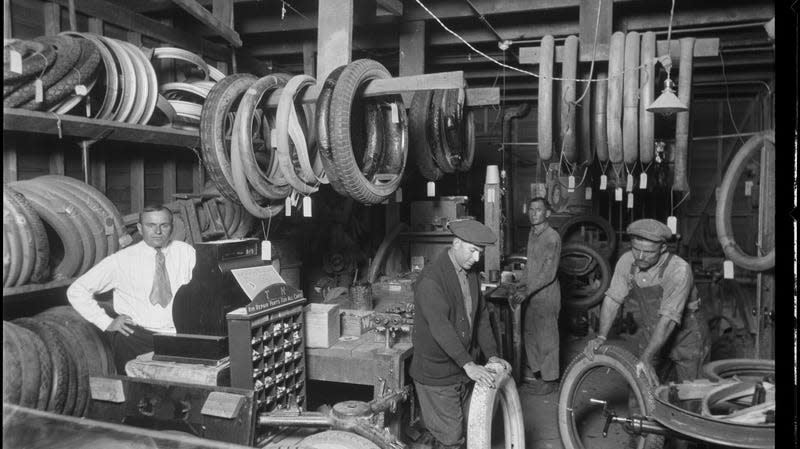
America in particular was hungry for the stuff. By the end of the ’20s, America was producing 50 million tires a year. Under a foreign cartel the price of the rubber needed for industry could rise from 20 cents per pound to $1.20–an unimaginable sum to the two industrialists. Firestone vehemently believed Americans needed a steady, preferably domestic, source for latex.
Ford already knew the benefits of sourcing his raw materials from his own lands and holdings. He owned vast stretches of woodlands and copper mines in the upper peninsula of Michigan, for example. Metal could be refined in a Ford-owned smelting facility and wood processed by a brand-new state of the art mill. One of the few pieces of the automotive puzzle he didn’t own was his own supply of rubber, which was needed not only for tires but gaskets, hoses, valves, wires and other crucial pieces of automotive assembly. Rubber was (and remains) as valuable as oil to the automotive industry.
But it wouldn’t just be rubber he’d be aiming to import to the U.S. He figured he could bring in hardwoods, exotic fruits and coffee as well. In return, he would bring to this wild land a certain way of American life—one that, as author Greg Grandin wrote in his book Fordlandia: The Rise and Fall of Henry Ford’s Forgotten Jungle City, was ironically fading quickly due to the kind of rapid industrialization championed by Ford himself.
Dearborn in the Jungle

Ford grew up on a farm in Dearborn, Michigan, just outside of Detroit. He was obsessed with marrying agriculture and industrialism together, despite the growing crevasse between the two. But Ford also knew that where there are decent paying jobs, there is vice. Ford provided reliable jobs in the economically depressed small town of Iron Mountain in Michigan’s Upper Peninsula. Dubbed the Rouge River of the North, once steady money came in, bars, brothels, gambling and violence quickly followed. Ford attempted to apply his strict regime of control on these far-flung workers as surely as he would the latex tree sap gathers–known as tappers–in the jungle. Town commissaries were not permitted to sell tobacco or alcohol, and lumberjacks in the woods were not permitted to lean against a tree for even a moment. Ford dictated what his worker’s homes looked like, paved their streets and set up whole communities.
The industrialist wanted to provide a utopia town with houses, theaters, schools and hospitals that closely resembled Dearborn. Ford even employed architect Albert Kahn, who was responsible for some of the most iconic buildings in Detroit including Ford’s River Rouge complex–the largest factory in the world at the time. Kahn designed a state-of-the-art hospital; a completely unheard of boon for the rural people of the Amazon.
Ford believed that, far away from corrupting forces like jazz music and cows’ milk, he could create the perfect worker; self-sufficient, agriculturally minded and sober, farmer and factory worker in one self-actualized capitalist cog.
We will get our men in Brazil. We are not going to South America to make money but to help develop that wonderful and fertile land…We’ll train the Brazilians and they’ll work as well as any others.
—Henry Ford in “Is Henry Ford a Genius?” by Dr. Decio De Paula Machado. The Magazine of Business, May 1928
Trust the Experts
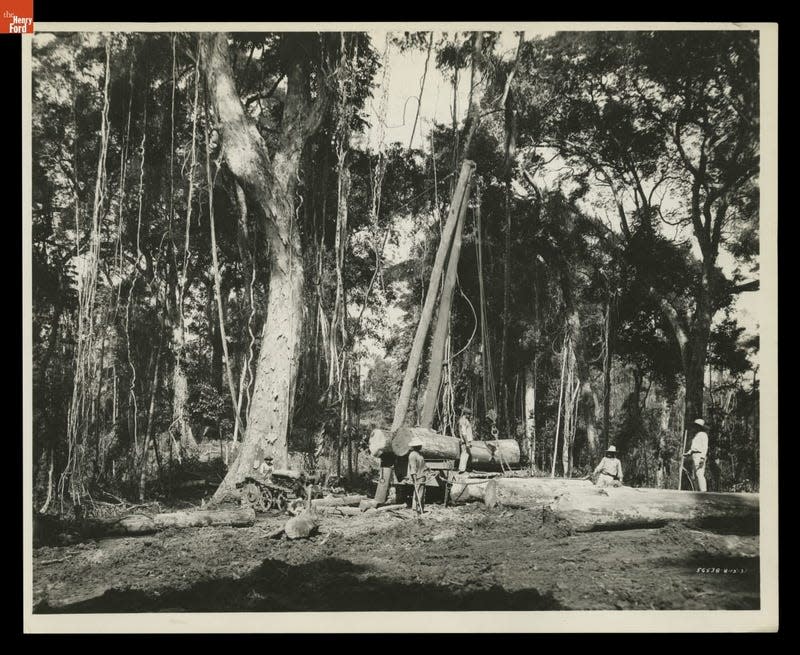
Ford considered several locations for his future rubber plantation. The company eyed the Florida Everglades and even planted a few test trees to see if industrial levels of latex could be cultivated from those swamps. He discussed a joint venture in Nicaragua with Firestone, or Liberia (which was axed as the Black population ironically wasn’t considered “civilized” or intelligent enough for plantation work). Instead, Ford figured the best place to grow rubber would be from its country of origin: Brazil.
And that might sound fairly logical. Almost like the common sense Ford so highly valued. But if Ford had trusted an expert, he would have quickly learned that a rubber plantation in the Amazon is a terrible idea. The thing about brasiliensis is that when it is cultivated overseas the plant has very few predators. In Brazil however, the trees face tons of potential dangers all adapted to specifically target every aspect of brasiliensis. Grouping them together in a plantation formation, rather than leaving wild jungle in between a few trees per acre, can cause pests and various funguses and molds to become endemic. And without the benefit of the jungle canopy, plantation-style planting exposed brasiliensis directly to intense sun and heat.
Doomed From Day One

Ford invested at least $20 million ($400 million in today’s dollars when adjusted for inflation,) years of work and thousands of employees into Fordlandia, and not one drop of rubber ever made its way into a Ford car. No exotic woods were processed and sent home. Still, even during the height of the Great Depression, when former and current Ford employees in Detroit held a Hunger March pleading for more hours and higher wages, Ford never gave up on his vision of orderly rubber trees marching into the distance.
The worst part? If he’d been capable of listening to anyone else, he’d have known the plan was doomed from the start.
A World Away

Rubber gathering was tedious, lonely and back-breaking work done deep in the jungle by heavily exploited indigenous and migrant laborers. This labor once made several ports along the Amazon extremely wealthy, but that wealth faded in the late 1800s, when the British got their hands on brasiliensis seeds. Much like Iron Mountain, which had exhausted its copper mines and timber reserves by the time Ford bought land, the rubber boom was long since busted by 1928, when Ford bought 2.5 million acres of jungle–roughly the size of Tennessee–along the Tapajós river, a major tributary of the Amazon river.
The remoteness of the site chosen by the company in 1928 can not be overstated. To this day, it takes 18 hours by boat to reach Fordlandia from the nearest center of civilization. When Ford management arrived on the banks of the Tapajós river they found a wall of green that blotted out the blinding equatorial sun.
Even before workers moved the first shovels full of earth and the diseased trees could fester in their fields, Fordlandia was already doomed to economic failure. In the face of the global shortage, rubber planting had increased in the South Pacific, and several European states decided against joining the cartel, rendering worries about increasing prices null. As Ford was setting up Fordlandia 1928, rubber prices had already fallen to pre World War I levels.
Fordism
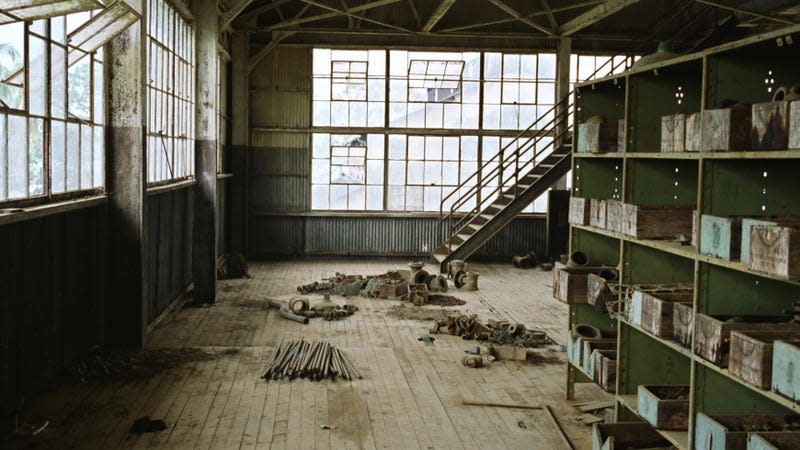
If it was a bad idea from the get-go, then why did Ford commit so many resources to Fordlandia? The answer can be found in a popular term from the early 20th Century: Fordism, which was first defined by the Washington Post as “Ford efforts conceived in disregard or ignorance of Ford’s limitations.” Ford often denigrated so-called experts, trusting common sense and creative thinking more than learning or experience.
“The moment one gets into the ‘expert’ state of mind a great number of things become impossible,” Ford said.
Consistently, when Fordlandia kept failing and losing money, Ford would turn around and pour more and more resources into it anyway. The experiment became more about civilization-building and social experimentation than turning a profit.
Heart of Darkness
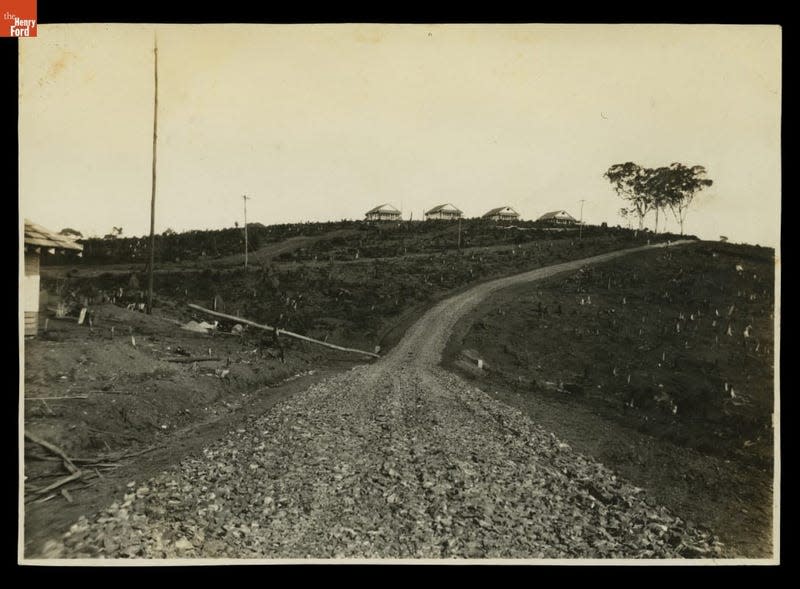
Once the land deal was finalized Ford immediately began shipping tools, supplies, building materials and trusted managers to the jungle on two ships–the steamer Lake Ormoc towing the barge Lake Farge. From the very beginning, the master capitalist was swindled, paying fees and bribes via a middle man for land that the Brazilian government was essentially giving away. Ford would found Forlandia in the jungle, followed years later by another settlement some 70 miles up the Tapajós called Belterra.
The first expedition set a tone for the town: an absolute nightmare mess that would put Joseph Conrad’s Heart of Darkness to shame. One man on the first trip to set up operations worked for Ford’s personal thug Harry Bennett. He tried to take over the emerging settlement as his own little fiefdom, shaving worker’s wages and pocketing the difference and making disastrous decision after disastrous decision before being recalled to Dearborn and subsequently fired.
Problems over taxes and bribes meant badly needed construction equipment sat in import houses costing the company a fortune. Once sent to the site however, the midwestern building material began to degrade. Ford lost tons of cement to the rain and humidity. Tools rusted. Wood warped and began infested with bugs. And that doesn’t take into account the human element.
U.S. Laws in the Jungle

The first step was gathering workers and clearing the land. When Ford recruiters managed to find workers from the surrounding area, they arrived to find no housing available for them or their families. Some single men slept in poorly ventilated quickly built bunk houses, but mainly men with families built camps along the river as they waited for promised homes to be built.
These camps quickly became the scene of frequent knife fights and drunken violence. Brothels opened almost immediately and proved so popular that Ford’s free hospital began charging for venereal disease treatments and workers were subjected to random inspections to ensure they were actually seeking out treatment when infected. The medical exams was just the start of Ford’s invasive management style. His managers attempted to uphold Prohibition, the law on the land in America. However when a few bars opened and, when managers attempted to shut them down, the establishments were protected by their machete-wielding patrons. Soon, a detachment of Brazilian soldiers with machine guns were keeping order in Fordlandia.
The Unconquerable Amazon
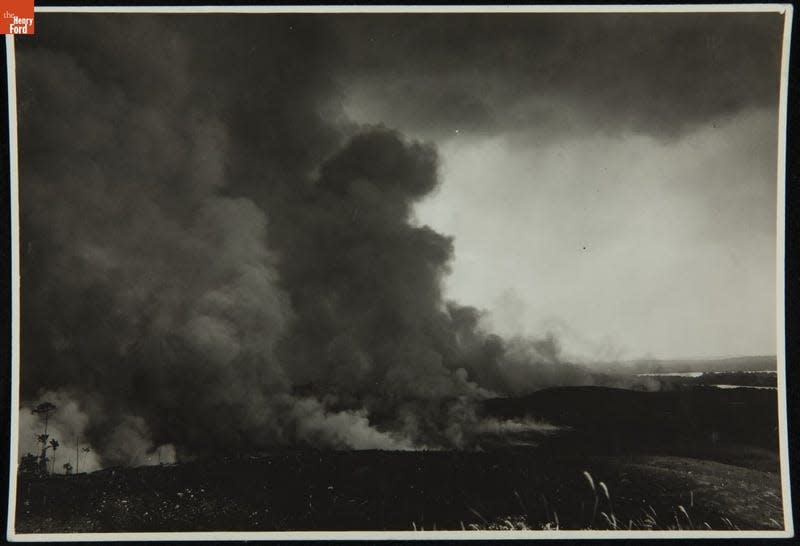
In their attempt to carve a clearing for civilization in the wall of green, managers made the wrong decisions at every turn. First, they did not give workers hats or helmets. While this may seem like a small oversight, it was incredibly common for nests of giant stinging insects to explode out in buzzing fury from even touching a vine or a branch.
Then Ford’s men attempted to fell trees and burn them where they lay– a common practice in the Amazon. But they started the cutting and burning during the rainy season when the wet wood wouldn’t fully burn, instead of letting logs dry out over the short dry season. The masters of this enterprise doused the remaining plant matter with kerosene. Witnesses said the fires were hellish and climbed high into the trees creating a terrible toxic black smoke and waves of terrified wild animals. It’s said to be the largest man-made fire in that part of the Amazon, according to a recent visit to the settlement by Insider.
Dying on the Plantation

The fire and insects weren’t the only hazards facing workers in Fordlandia. In the Amazon the traditional tappers of the rubber trees do not work during the rainy season at all, and soon it was clear why–death and debilitation was rife. In the early days of the settlement, up to a quarter of workers could be found in the newly-built hospital at any given time. By the end of the first year alone, 90 graves filled Fordlandia cemetery. Death came to workers via malnutrition, common jungle diseases, viper bites, or infections from ant, wasp or vampire bat bites. One worker drowned in the river after having her arm ripped off by a caiman. Before houses could be built, jaguars would snatch infants from their cradles in the camps.
A small riot ensued in November 1928 when rancid meat and fish was delivered to the kitchen. To surpass problems like these and to support American health crazes at the time, Ford decreed only oatmeal, canned peaches, rice and whole grain bread would be served in the mess. This plain diet, so foreign to people used to a wide variety of foods, would ultimately be the final straw for Fordlandia.
Forcing Midwest Norms in the Jungle
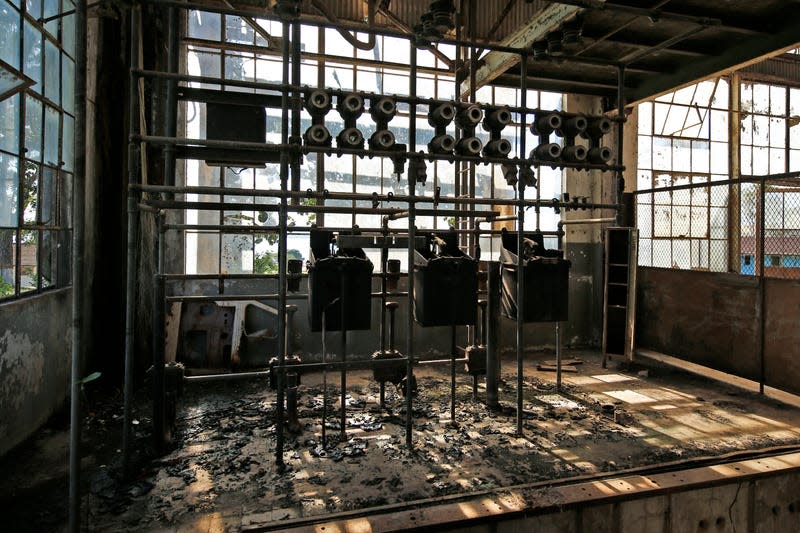
It may not come as a surprise that turnover was also a problem. Amazonian people were used to seasonal work–planting or tapping rubber trees in the mornings and evenings of the dry season and waiting out the torrential downpours and terrific heat and humidity of the rainy season. But Ford pushed workers to toil for a 9-to-5 work day, when the heat could reach 106 degrees with 100 percent humidity. Often workers would put in hours just enough to save up and then simply walk off the job. It didn’t help that many people in this region had never had a salary before. Barter or credit were the most familiar forms of transaction to workers in the Amazon. The idea of “punching in” by a certain time was equally foreign to them.
Ford managers blamed the jungle’s endless supply of fruit and bush meat for the mass job abandonment. If workers didn’t live in fear of starvation, then why should they work?
It couldn’t be the cruelty of the overseers, who drove workers hard in one of the least hospitable terrains on the planet, or the fact that Henry Ford had promised his famous $5 a day for workers, but in actuality only planned to pay about 35 or 45 cents a day. Still higher than the average salary in the region, but certainly not enough to deal with the danger caused by managerial ineptitude. Or it could have been the useless tools, which tended to rust into nothing in the soggy landscape or shatter under the strength of Brazilian hardwood. Bags of concrete would sit in the rain and turn into lumps of immovable rock. The poorly built dirt roads would turn into mud pits during daily rains, making moving lumber to the newly built sawmill impossible or, at least, unprofitable to reach with the massive trees. Any trees that were processed soon warped and became bug-eaten in the incredible humidity and heat.
Soon, Fordlandia was experiencing the kind of turnover that Ford experienced at his Highland Park plant. For every 1,000 positions available in Fordlandia the company had to hire 4,000 workers.
The 1930 Mess Hall Riot
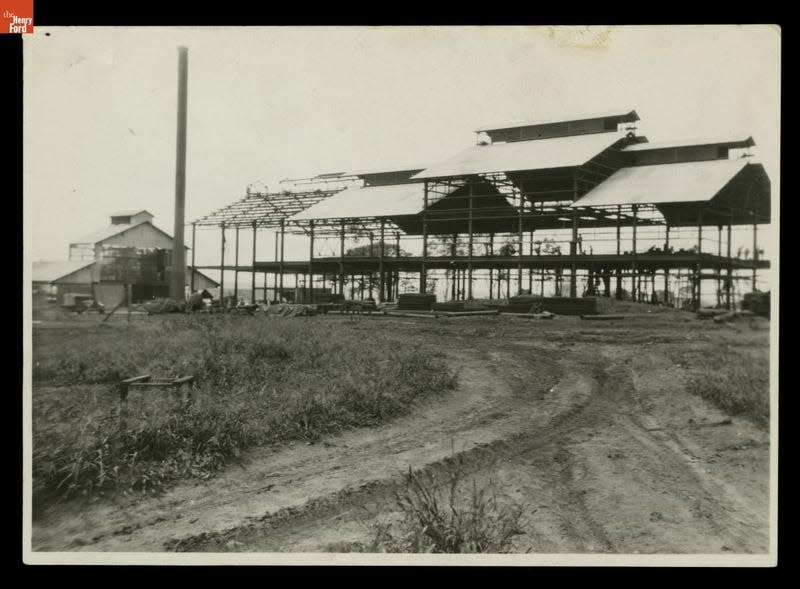
But still, Fordlandia was something of a marvel when the town finally found its footing. Ford built a water tower that was the tallest manmade structure in the Amazon which provided fresh, treated water to the homes of managers and laborers alike–an absolutely unheard of luxury in the heart of the Amazon. Ford built dirt roads, railroads, warehouses, a first-rate hospital and even leisure activities like a movie theater, dance hall and 18-hole golf course and a swimming pool (for management only of course). Workers planted over 3 million rubber trees on clear-cut fields surrounded by lush forest.
The year 1930 would bring more problems. Ford’s men began instituting a local version of what was called the “service department” back in Dearborn. Homes and bunks were regularly searched for offending bottles of alcohol. “Sanitation squads’’ and “medical teams” routinely inspected the dirt-floor shacks that counted as the slightly nicer dwellings on the site. While they maintained latrines and drained mosquito infested ponds they also dictated how families should sleep in their small houses and how laundry should be dried. Ignoring local custom and tradition which put the entire camp on edge.
For single men forced to eat in the company dining hall, things were much worse (men with families could go home for meals). Ford managers decided these workers who were required to eat in the mess hall should be charged for the bland meager Midwestern food provided from the company–oatmeal for breakfast and brown rice and wheat bread for dinner with the possibility of canned peaches every so often. Managers also changed from serving workers to a buffet system. This pushed workers already angry about the bland diet to riot. They destroyed the mess hall and trashed most of the small settlement, sending management fleeing into the jungle or out on to boats to wait out the riot in the middle of the river.
In the middle of the worst years of the Great Depression, Ford spent millions rebuilding Fordlandia, but the writing was on the wall. The plantation was failing to thrive as diseases and predators decimated the groves. It was time for more dramatic moves.
Belterra
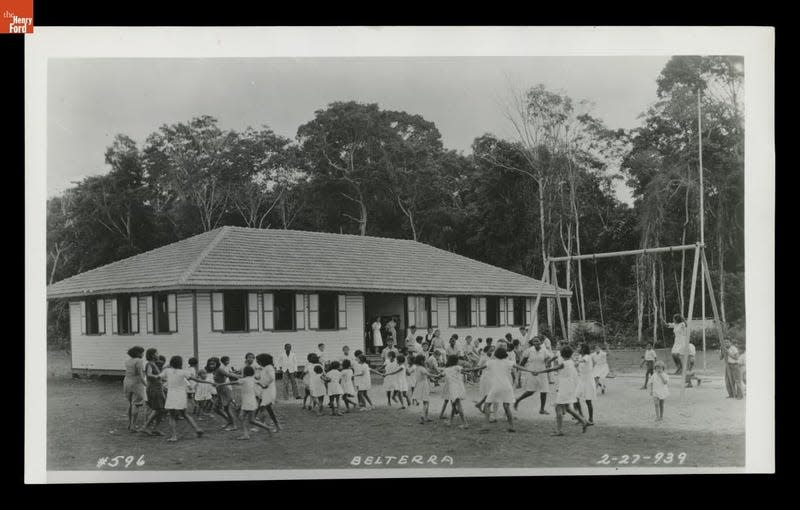
About 70 miles down river, the Ford Motor Company founded Belterra in 1931 and restarted the entire process. Fordlandia was downgraded to simply a rubber research facility, though the hospital would continue to provide the best possible care in the area for years to come. The company actually imported rubber trees from southeast asia to Brazil this time as well, hoping the foreign trees might resist the natural predators of fungus and insects a little better than native plants.
Belterra was the more successful of the settlements by far thanks to Ford loosened the American-style restrictions and adopting Brazilian food and customs. Ford did, however, enforce another obsession of his: education. In Belterra, Brazilian and American children were taught side by side. There was a strict dress code (with clothes provided for the children by the company) and a focus on hands-on learning and good citizenship. Children were also taught ballroom dancing, gardening, and skills needed for their futures as either laborers or housewives.
Belterra was also simply in a better spot for a settlement–the landscape was flatter, straighter suburban streets were lined with red fire hydrants and dotted with parks. There were several main street shopping centers and some of the most advanced sanitation and indoor plumbing in the Amazon. All told Belterra looked and felt much more like Dearborn than Fordlandia ever did. The site even produced 750 tons of latex by 1942–far short of the 38,000 tons Ford needed to keep up with production. While Belterra could have reached that mark within a decade, the leaf fungus that decimated Fordlandia’s groves came back with a vengeance.
Fordlandia was downgraded to simply a rubber research facility, though the hospital would continue to provide the best possible care in the area for years to come. Henry Ford II, Henry Ford’s grandson, would pull the company out of both sites in 1945 after the end of WWII sent cheap rubber from the east once again flooding the world market. Belterra was faltering due to fungus and disease again, and the company decided to close up shop for good. The Brazilian government bought the land back at $250,000—a mere pittance of what Ford spent.
Fordlandia Today
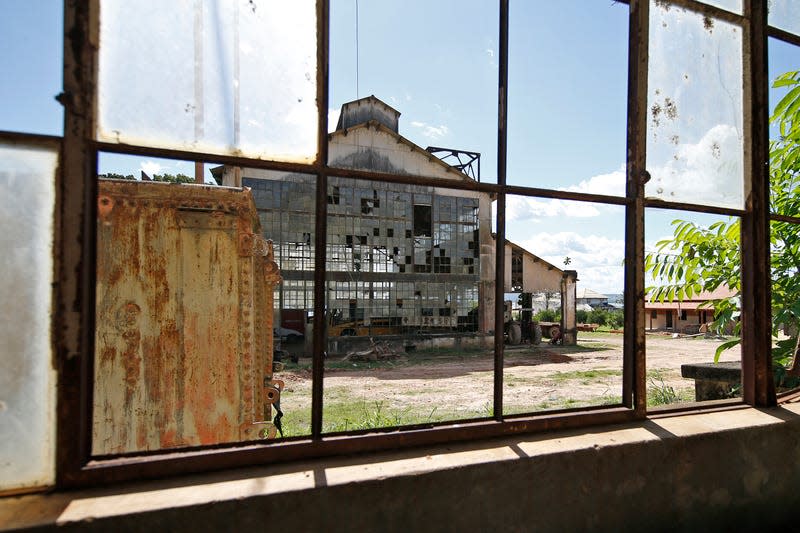
When author Greg Grandin went to Fordlandia, now called Aveiro in the Brazilian state of Pará, for his book Fordlandia: The Rise and Fall of Henry Ford’s Forgotten Jungle City he found some of the descendants of Ford workers still living in the area. A few dozen residents live near the bank of the Tapajós river, with some taking over many of the former Ford-built houses and maintaining them to prevent the jungle from pulling them apart. A visit from Insider in 2022 found a man still using the lathe machines in Fordlandia’s workshop–the same machines his father had operated for Henry Ford. It still takes 18 hours to travel to the sites via boat from the closest outpost of civilization.
Fordlandia still exists today, not as an overgrown jungle ruin but the kind of rusting industrial wreckage familiar to anyone from a Rust Belt city. Between the hulking, empty warehouses, dilapidated buildings, low employment and high poverty rates in the area, Ford seems to have finally achieved something remarkable, turning this slice of the Amazon into an unfortunate transplant of American industrialism 100 years later.
More from Jalopnik
Sign up for Jalopnik's Newsletter. For the latest news, Facebook, Twitter and Instagram.

 Yahoo Autos
Yahoo Autos 